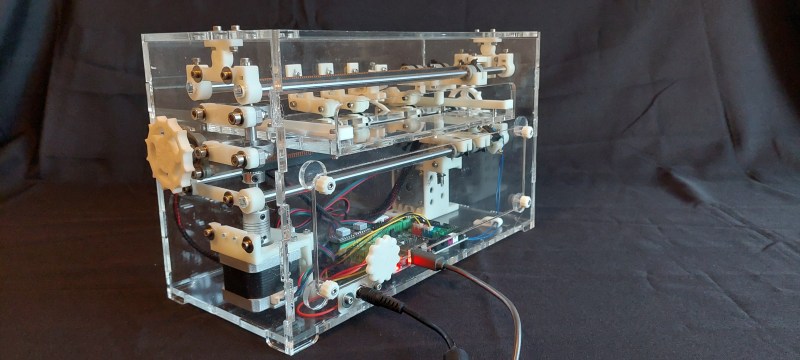The limited availability of texts transcribed to Braille and the required embossing equipment is a challenge world wide, but especially in poorer countries. To alleviate this problem, a team makers from in Cameroon have been developing BrailleRAP, an open source Braille embosser.
BrailleRAP is built built using commonly available 3D printer components, printed parts, and a laser-cut acrylic or wood frame. Paper is fed between a pair of carriages, the bottom one punching dots with a solenoid while the other acts as the anvil. Sheets of paper are fed in one or two at a time with stepper controlled rollers to control the position. At a cost of about $250, it is about a tenth of the price of the cheapest commercial solution, and the team have created excellent documentation so anyone can build it.
BrailleRAP was inspired by BRAIGO, another Hackaday-featured embosser assembled LEGO Mindstorm parts. We also featured another simple, but ingenious handheld embosser for portable use.



















Nice!
I wonder if it might be possible to repurpose a dot matrix printer to make braille impressions at high speed.
Got the same ideea years ago, but there are some issues: 1. the needles are thin, they’ll punch a hole/shred the paper/cardboard, 2. either move an anvil in the place of the rubber roller or made little holes in the rubber roller (golfballify the roller) or 3d print a plastic roller with the holes. 3. the needls have short traveling distance.
It was my idea too. And I believe it would be possible but not very practical.
You would have to change the print head to be a stronger one, and it would add weight. And it would take more current, so you would need beefier wires. And change printer firmware because it would not print the file as it got from the PC…
You could grab a non-functional printer and convert it…
I think that a better approach would be special paper with a non-toxic, hygroscopic layer, but one that only reacts (and expands) when it makes contact with alcohol… like the one used in the inkjet printers. That way, a normal inkjet printer would be able to print braille, because the layer would expand where the ink makes contact.
A beautiful project in every sense. The system itself is lovely to watch in motion, the hardware is well considered, and the documentation is comprehensive. Inspiring!
Intumescent polymer sheet and a CNC laser is the fastest option.
Great project, seems to work pretty well too. Well done!